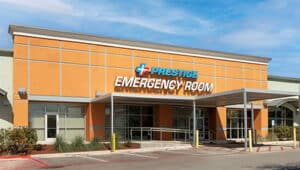Skin rashes can often be treated at home safely, but when they can’t, and complications arise, Prestige ER can help with same-day, high-quality care and treatment.
Our skilled medical professionals will quickly assess and treat severe rash symptoms or allergic reactions, ensuring you receive prompt care and fast relief.
Understanding Rash Emergencies
What Causes Rashes?
Rashes can be caused by several factors, such as:
- Food allergies.
- Contact dermatitis (e.g., poison ivy, nickel).
- Insect bites or stings.
- Bacterial, viral, or fungal infections.
- Skin conditions (e.g., eczema, psoriasis, seborrheic dermatitis).
- Other irritants (e.g., soaps, detergents, chemicals, heat, and humidity).
- Certain medications.
- Hormonal changes.
- Stress.
- Autoimmune disorders.
- Genetics.
When to Monitor vs. Seek Emergency Care
If your rash is mild, gently wash the affected area with mild soap and warm water, pat dry, and avoid harsh chemicals, scratching, or rubbing. Carefully monitor your rash and watch for signs of spreading or changes in appearance.
If your rash is spreading quickly, changes its appearance, becomes painful, or is accompanied by one or more of the following, you have a serious rash that requires emergency care at your nearest Prestige ER location:
- Fever.
- Joint pain.
- Headache.
- Tightness in the throat.
- Shortness of breath.
- Streaks of red leading away from the rash.
- Blisters, peeling, or pus.
- Abnormal bleeding or areas of bruising under the rash.
Emergency Signs That Require ER Treatment
If you or a loved one is experiencing severe rash symptoms, you should visit your nearest ER for a rash assessment and prompt treatment.
Severe or Spreading Rashes
A severe rash that is spreading quickly could indicate a serious allergic reaction (anaphylaxis), infection, or adverse reaction to foods or medication. Anaphylaxis is a potentially life-threatening condition that requires immediate medical treatment.
Rashes With Dangerous Symptoms
Rashes that can cause severe, life-threatening symptoms include:
- Stevens-Johnson syndrome (SJS) and Toxic Epidermal Necrolysis (TEN)
Caused by an allergic reaction to medications. - Toxic shock syndrome (TSS)
Caused by toxins released by bacteria. - Staphylococcal scalded skin syndrome (SSS) or Ritter’s disease
Caused by a bacterial Staph infection. - Cellulitis
Caused by bacteria entering the skin through a wound. - Hives (urticaria)
Caused by an allergic reaction, infection, autoimmune disorders, thyroid disorders, or stress. - Anaphylaxis
Caused when the immune system overreacts to an unknown or foreign substance (e.g., an allergen). - Shingles
Caused by the reactivation of the varicella-zoster virus (VZV), also known as chicken pox. - Heat rash (miliaria)
Caused by blocked sweat ducts on the skin.
When to Seek Emergency Care
Seek immediate care for a rash if it:
- Spreads quickly.
- Involves blisters or open wounds.
- Shows signs of infection (e.g., oozing, swelling, warmth, tenderness, or a red streak around the affected area).
- Causes difficulty breathing.
- Is accompanied by severe pain, confusion, fever, persistent vomiting, signs of dehydration, or worsening of chronic conditions.
What Happens at the ER for Rash Treatment?
If you visit Prestige ER for rash treatment, here is what you can expect:
- Prompt assessment of your condition.
- Medical history and physical examination.
- Medications to minimize discomfort and the risk of complications.
- Stabilization and re-assessment.
- Post-visit care and referral to a specialist, as needed.
Urgent Care vs. ER: Where to Go
Should I go to the ER for a rash? If you, your child, or a loved one is suffering from a skin rash, it’s important to know where to go.
Here are a few guidelines to help you make a quick, accurate decision:
Visit an urgent care if your rash:
- Appears mild or localized to a small patch or specific area.
- Is not accompanied by severe symptoms of pain, fever, or difficulty breathing.
- Does not show signs of infection.
- Is itchy, but manageable without extreme discomfort.
Visit an emergency room if your rash:
- Covers a large portion of your body.
- Is accompanied by severe symptoms of pain, fever, or difficulty breathing.
- Is accompanied by swelling of the face or throat.
- Shows signs of infection.
Preventing Severe Rash Complications
Whether you have an active rash, are prone to allergic reactions, or are just looking for trusted advice for preventing severe rash complications, here is what to keep in mind:
- Go to your nearest emergency room at the first sign of fever, pus, or difficulty breathing.
- Follow all medical advice or treatment plans provided by your primary care or emergency room doctor.
- Identify and avoid known triggers (e.g., food, plants, chemicals, medications, etc.).
- Practice good hygiene with gentle cleansers and moisturizers.
- Protect your skin when handling potential irritants.
- Wear protective clothing when out in the sun.
- Wear sunscreen.
Prestige ER provides rapid care for many medical emergencies, including severe rashes and allergic reactions. We are veteran-owned and dedicated to providing excellent emergency services to our San Antonio community. Our mission is to provide personalized, superior care for you and your family—365 days a year, 24 hours a day.
Find a location and visit us today.












